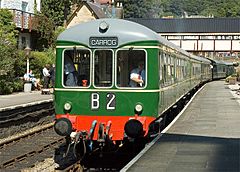British Rail Class 109 facts for kids
Quick facts for kids British Rail Class 109 |
|
|---|---|

Preserved unit 50416+56171.
|
|
| In service | 1957- |
| Manufacturer | Wickham & Co |
| Number built | 1957 |
| Formation | 2 cars per trainset |
| Operator(s) | British Rail |
| Specifications | |
| Car length | 57 ft 0 in |
| Width | 8 ft 3 in |
| Height | 12 ft 4 1/2 in |
| Maximum speed | 70 mph (112 km/h) |
| Weight | 37 tons 10 cwt |
The British Rail Class 109 was a special type of train. It was a diesel multiple unit, which means it was a train that could run on its own using a diesel engine, without needing a separate locomotive to pull it. These trains were built in 1957 by a company called Wickham & Co.
What is the British Rail Class 109?
The Class 109 trains were designed to have two cars per train. This means each train was made up of two connected sections. Only five of these two-car trains were ever built.
How Were They Designed?
These trains had a very unique body design. It was different from other trains built around the same time. This made them stand out.
What Happened to These Trains?
Even though they were special, the Class 109 trains soon became "non-standard." This means they didn't fit in with the usual types of trains British Rail was using.
Because of this, two of the units were sold back to the company that made them, Wickham & Co. Wickham & Co then sent these two trains to Trinidad and Tobago, a country in the Caribbean.
Another Class 109 train was changed for a different purpose. It was used for "departmental service." This means it was used by British Rail staff for things like maintenance or inspections, rather than carrying passengers. This particular train stayed with British Rail until the early 1980s.

